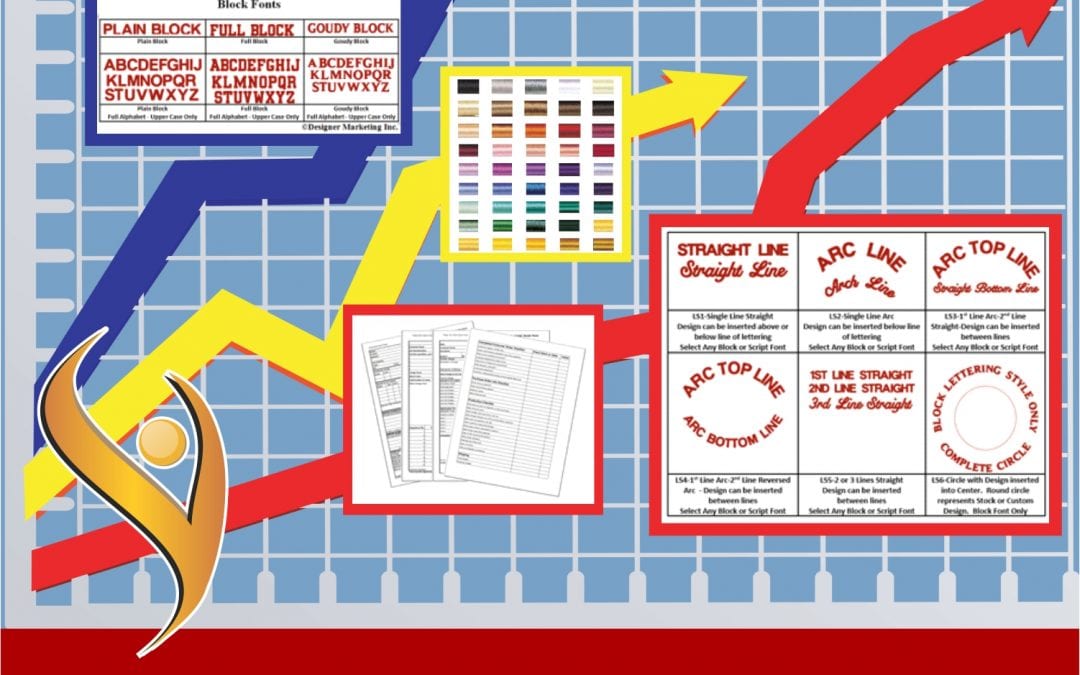
by The Embroidery Coach | | Embroidery Business Marketing
Do you find yourself frustrated when you have to stop to wait on a customer? Is your customer ordering process taking up too much of the time that you need to spend on your production? Helping customers make quick buying decisions can sometimes be very frustrating. I want to talk about how you can cut back on the amount of time that it takes you to help your customers make a final decision. My Inner Circle students know how important this is and it is a priority in setting up your business to run properly!
As embroiderers, we want to be able to offer our customers a full range of lettering and design options but in the process of doing so, we sometimes have the tendency to over complicate the process causing us and the customers unneeded frustration. There are 5 simple ways that will help to save time and speed up your customers ordering process.
- Embroidery Design Layout Options
- Limited Lettering Style Options
- Samples Tagged With Ordering Information
- Thread Chart
- Organized Ordering System
Embroidery Design Layout Options
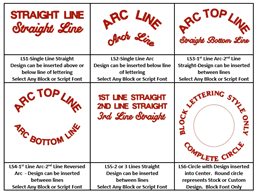 Create several Design Layouts Options for your customer to choose from. By giving your customer choices of different layouts for him to look at before he places his order, you prevent him from asking you to create his logo with several different options for his approval.
Create several Design Layouts Options for your customer to choose from. By giving your customer choices of different layouts for him to look at before he places his order, you prevent him from asking you to create his logo with several different options for his approval.
These Design Layout Options save time and instill confidence in the customer that you know what you are doing and know what the best option for him or his logo will be.
Limited Embroidery Lettering Style Options
In each of the embroidery software packages today you have many lettering styles to choose from and it is very 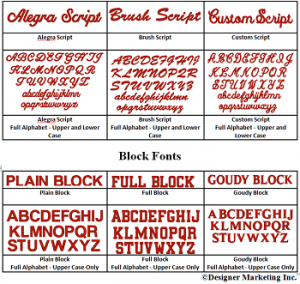 tempting to want to show our customers all of the lettering styles that we have available.
tempting to want to show our customers all of the lettering styles that we have available.
By limiting the embroidery lettering style options, you not only save time working with your customer in their selection, but you also save time in the setup of your lettering designs. If you are only working with a few lettering style options, you can have templates made ahead of time with all of the style settings included in the template. This is a huge time-saving process when you are creating your customer's design setups!
Sample Tags With Order Information
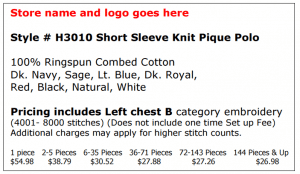 Your showroom should be complete with high-quality embroidery samples that are tagged with all of the order information that is applicable to that product sample.
Your showroom should be complete with high-quality embroidery samples that are tagged with all of the order information that is applicable to that product sample.
Having all of your samples tagged ahead of time with the appropriate information will save you a lot of time and prevent you from having to look up the information in the catalogs. As your pricing changes, so do your Sample tags. Always keep them up to date with all of the correct product and ordering information!
Your Own Company Thread Chart
Creating your own company thread chart is very important. You should never offer to show the customer the thread 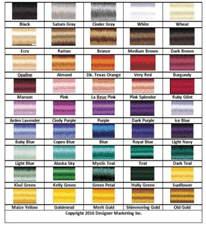 chart from the company where you purchase your thread.
chart from the company where you purchase your thread.
Many embroiderers order the thread that their customers want and end up spending their entire profit for the job or more just because they do not have that particular color in stock. The thread then sits on their shelf and very often rots because no one else is going to use that particular color.
If they are not happy with your selection, offer to order their custom color but make sure that they understand that there will, in fact, be an additional charge for this service. You will need to charge for the thread as well as the shipping into you.
An Organized Ordering System
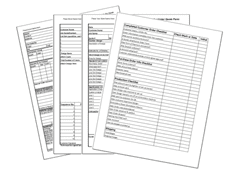 An organized ordering system is simple to put into place. This is true when you have all of your information computerized and even if you are using paper forms to be filled out while you are waiting on the customer. You can create Sales Order Packets with all of your forms included so that you do not have to look for your information forms while you are working with your customer. Inside of this Sales Order Packet, you should have:
An organized ordering system is simple to put into place. This is true when you have all of your information computerized and even if you are using paper forms to be filled out while you are waiting on the customer. You can create Sales Order Packets with all of your forms included so that you do not have to look for your information forms while you are working with your customer. Inside of this Sales Order Packet, you should have:
- Customers Quote form
- Your Order Form
- Form of Payment
- Production Timing Form
- Artwork Production form
- Packing Slip
- Checklist
I have gone over 5 ways to help customers make quick buying decisions. You want the order process to be a pleasant experience for both you and the customer. When you offer your customers so many options they only get confused and it takes longer for them to make a final decision and sometimes that final decision is no decision. Reducing the number of choices you have to offer will save you and the customer a lot of time and will help customers make quick buying decisions!
To get started with your Embroidery Sales Tools click here!

by The Embroidery Coach | | Embroidery Business Management
Have you said to yourself: I am running out of time in my business and I cannot do it all myself anymore. I think that I need someone to help me with my work, but where do I begin and when should I hire someone to help me?
Before you decide to hire someone to help, you need to take a really hard look at your business to see if you have everything set up properly and efficiently and are actually ready to hire someone. Ask yourself these questions first to help get this part figured out.
- Is my accounting system set up properly so that it only takes me a couple of minutes to create an invoice and I know that it is all going into the right accounts?
- Do I have a logging in system so that I can easily keep track of all of my jobs and I know when each and every one of them is due?
- Do I have a system for scheduling my work so that it flows easily?
- Do I have written instructions for every step or process in my business?
If you cannot answer yes to all of these questions, you are not ready to hire someone to help you. If you hire someone before you have all of this in place, you will not get the most for your money and you will be spending many long hours training someone and fixing mistakes because you have not had the time to train them properly and still keep up with your own work!
I know about this, been there and done that! This is a big step and if not done properly, you absolutely will waste your money.
First of all, the first person that you need to hire is someone to help you with your accounting and if it is set up properly, this would be someone that is very part-time. By that, I mean maybe one afternoon a week at max.
The next person to hire is someone to train to do the finishing of your garments. This is someone that pays attention to detail and is good with their hands.
DO NOT try to hire someone to do your customer service for you. You are the face of your business and you need to stay the face of your business for a very long time. I have seen other people make this mistake thinking that they can do the production part better and faster and someone else can take care of the customers.
Trying to decide when it is time to take on employees can be a very tough decision but after you have the first set of question answered yes and have everything in place that is necessary, the next set of questions to ask yourself that might help you make this decision.
- Do I have so much work that I cannot get it all done within the time frame that I have promised my customers?
- Am I not answering the phone because I already have too much work to do?
- Are the simple tasks that I am currently doing bringing in the amount of money that I need or am I wasting my time doing them when I could be paying someone a lower wage than what I want to make per hour?
- Am I not getting my invoices out on time and that is at the very completion of each job?
If you are answering yes to any of these questions then it is time to hire someone to help you.
What Can You Offer The New Employee?
Now that you have established that it is time to hire someone, you want to take a look at what you can offer someone in the way of compensation and benefits. This is very important and you must have it totally in place before you start talking to potential employees.
If you are not financially in a position to offer a high paying wage when this is a requirement for the position, then you must be ready to offer some extra benefits to compensate for the loss.
Determine what you can offer in the way of benefits.
- Are you in a financial position to pay a good or competitive wage?
- What type of benefits are you willing to offer to attract the type of employee that you are looking for?
- Do you offer any vacation time with pay? If so, how many weeks?
- Do you allow sick days off with pay? How many?
- If they do not take all allowable sick days or vacation, do you compensate them at the end of the year for this time?
- Do you offer or provide health insurance? Is this deducted from their wages or do you provide it free of charge? How much is deducted? What type of plan do you offer?
Where to find a Good Employee
If you are looking for a part-timer to help with your accounting, talk to your accountant. He or she may know of the perfect person for you. You may have to pay them a high dollar per hour but you are looking at very few hours per month if you have your QuickBooks set up properly.
If you are looking for someone to help you with your production, Word of mouth is the best way to find a new applicant but this does not always work out. Current employees may know of someone that is looking for a job. Tell your friends and family that you are looking for a well-qualified employee. A word of caution: Do not hire more than one person from the same family. I have found through experience that this can cause issues.
I have had an excellent response by running ads on Craig’s List. However, this does not work in all parts of the country. This is something that can be done for free and it is simple to do. I created a simple ad that has worked in the past. You can place the ad on Craig’s list and see how it works for you.
Title: Embroidery Machine Helper!
Body of ad
- Some sewing knowledge required!
- Must pay attention to detail!
- Must be able to understand and use a ruler!
- No embroidery experience required!
- Part Time but may work into Full Time
Respond to:
|Reply at 455-555-5555 or email to help@youremail.com
One of my students hires only Graphic Artists from the local college. He starts them out on an internship to see if they are going to work out before he actually hires them full time. They have a very good understanding that this is only a trial period and they will get hired if they can do all that is expected and is a good employee as far as attitude and his or her ability to work with others.
Place an ad on a bulletin board in a grocery store. Housewives or retirees are great prospects. They may not be able to work full-time but would work out great as a part-time employee and would usually give you their 100% while on the job. They usually have good organizational skills and work ethics. Housewives or home sewers usually have a lot of experience with bobbins and threading needles. Good dexterity is very important.
What questions to Ask In The Interview
Before you start your interview process with each applicant you need to know the right questions to ask. A new applicant does not need to have experience in the embroidery field but there are basic skills that are required before they can even be considered. As a matter of fact, I always hired people that had no experience. It is very hard to retrain someone that has learned bad habits. It is easier to train them from scratch, so to speak!
- Do you have previous sewing experience? This is not necessary but it does help. They would already have basic knowledge of threads, needles, scissors, thread tensions and possibly machine maintenance.
- Do you have any computer knowledge? Not a requirement but it also is very helpful and shortens their learning curve if this will be a tool that they would be using.
- Do you have small children? In some states, you cannot ask this question directly so you will have to be careful. If so, who takes care of your children when they are sick? This should not be held against them, but it needs to be addressed up front.
- Do you know how to read, write, count and use a ruler? This is very important especially if it is a person that does not speak the same language on a daily basis. They will be required to read and write to fill in production reports.
- Can you stand for long periods at a time?
- What are your hobbies? Let them explain this to you.
- What do you consider your strengths? What do you feel you are good at?
- What do you feel are your weaknesses? What do you feel you are not good at?
- Would you be willing to tidy up at the end of the day?
- Would you be willing to clean and maintain the equipment that you will be using?
- Can you carry boxes full of garments?
- Would you be willing to move at a fast pace when the pressure is on?
- You must be willing to learn, listen and take orders. Does any of this bother you?
- Can you take constructive criticism?
- Do you have specific work hours that work better for you than others?
- Are you looking for Full-time work or Part-time work?
- Are you looking to advance in your position?
- Are you willing to be trained on a continuous basis?
- Why did they leave their last job?
- How was their boss or supervisor to work with? (If they talk bad about their former boss, this may not be the type of person you want to have in your place of business. They could be poison for the rest of your employees)
Having an in-depth conversation with your applicant following these questions will tell you a lot about this person. These questions can be part of your application process on a questionnaire that they can fill out. After reviewing their answers and you feel that this is a person you would want to hire you can then schedule them for an interview. It will save you a lot of time in the hiring process. It is not necessary to keep bringing them in for a second or third interview. This is a waste of your time and their time.
If you have decided to hire someone to help, make it clear at the end of the interview, that this will be a 30-day trial and have a specific list of tasks or procedures that you expect them to master.
Give them a clear job description and let them know that they will be evaluated on this description and specific list of tasks at the end of that 30-day trial.
To get yourself organized, and set up your processes so that you can be ready to hire someone to help you, Click here to start the 9 Steps to a Profitable Embroidery Business! This is extremely important and will help you get on the right track! Without this, you are wasting a lot of valuable time!
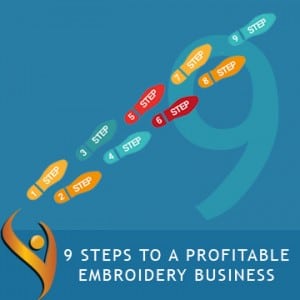
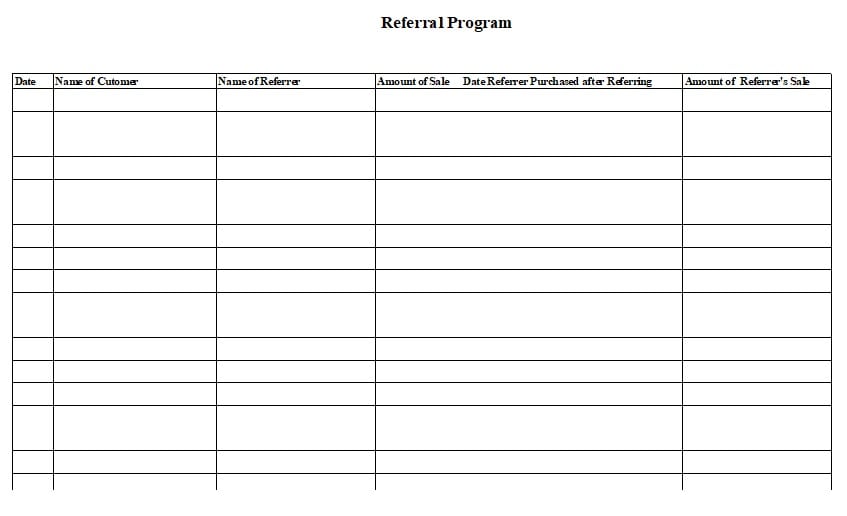
by The Embroidery Coach | | Embroidery Business Marketing
Setting up a Simple Referral Program for your Embroidery Business takes only a few minutes and it so worth it! Asking for referrals is one of the most effective, quickest and least expensive ways of gaining these new customers. Setting up a system to reward customers for referrals by giving them a discount on their next order is always effective. How do I do this? There are several ways of asking for referrals.
- Have Business cards Tucked Into Customers Pick Up Bags.
- Send Out Business Cards Or Brochures With Invoices.
- Ask For A Referral After Customer Has Placed Their Order.
- Tell Employees About Referral Program
Have Business Cards Tucked Into Customers Pick Up Bags
The easiest and most effective way that I found was to always give my customers business cards and brochures. When they pick up their order, make sure to add business cards or brochures to their package. Ask them to write their names on the back of the cards or brochures and hand them to their friends, family and acquaintances. When the person comes into the shop that has been referred, take their business card and keep track of the person that referred them to you. The person that gave the referral would then get a discount on their next order. Everyone wants to get something for giving out your name. As I said there is a small cost to it, but this is a customer that you did not have to go after.
Keeping Track of the Referrers
I set up a simple spreadsheet for my Referral program. On that spreadsheet, I put the Date, Customers Name, Name of Referrer, Amount of Sale, Date Referrer Purchased after Referring and Amount of Referrer‚’s Sale. This helps me to keep track of the amount of sales that are brought in by the Referrers and who the Referrers are. You can increase your reward for those that give you a lot of referrals. This is the best type of Salespeople that you can have!
Tell everyone that you know about your Referral Program including your employees. This is a simple way to set up a Referral program for your Embroidery Business that WORKS!
Click on the link below to get your copy of my Simple Referral Program Spreadsheet!
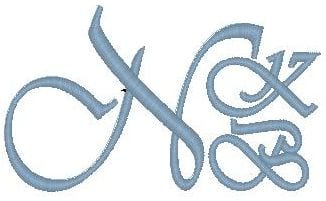
by The Embroidery Coach | | Embroidery Business Marketing
If you currently offer your customers monograms, you can now offer them custom one of a kind monogrammed gifts for the holidays. This will help them to create lasting memories for their loved ones during this holiday season!
The Holiday season is when we like to connect with family and friends that we do not see on a daily basis. This is the time of year when many special memories are created or brought into the forefront of our minds. I love this time of year!
When I was growing up we did not have very much in the way of material things but my mother always made Christmas very special and I will never forget all of those special holidays!
December is the month of many winter weddings and this is the time when we like to offer our customers a little something special. During the holiday season most embroiderers get requests for monogrammed gifts from their retail customers as well as their business customers that are in the market for employee gifts.
This is also the time of year when you have more customers coming into your shop than normal and they are looking for something new that they have not seen before. This gives you the opportunity to showcase many of your new ideas and helps you gain more customers that will be back to shop during the coming year. One of a kind monogrammed gifts are always popular for the holidays, weddings, bridal showers and house warming gifts!
Offer Your Customers The Option of One of a Kind Monogrammed Gifts
When I first started getting requests for monograms that I did not have the font for it was so frustrating to me. I did not have the money to invest in fonts to create one or two monograms. During this frustrating time, I learned how to edit the fonts that I had in order to create one of a kind monograms that my customers loved. These one of a kind monogrammed gifts can become heirlooms that help create the same warm feeling of memories that are created during the holiday season.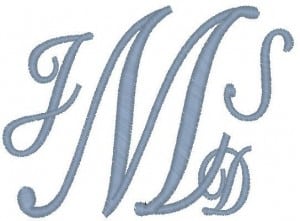
I am offering a special discount on the How to Create Beautiful Large and Small Monograms program that I have created that teaches you how to edit your standard embroidery fonts and work with true type fonts to create your own line of one of a kind monograms.
This on line video training program will show you step by step exactly how to create beautiful heirloom monograms and how to create full monogram sets from washcloth size to shower curtain size. You can watch me while I show you exactly how I accomplish this. I have even included a special heirloom type font that I digitized for you so that you can offer something very special quickly for the holidays!
This is what made a huge difference in my business and I was able to offer my clientele something very special that no one else in our area could offer! This was pretty exciting to me and it helped me to build up a high end clientele.
Go to HowToCreateMonograms.com and place your order today so that you do not miss out on this amazing opportunity to be able to offer your customers something really special in one of a kind monogrammed gifts for the holidays! Get immediate access to these on-line videos teaching you how to create these beautiful one of a kind monograms!
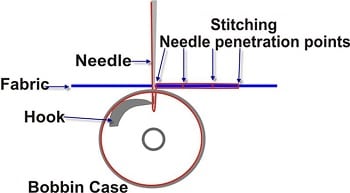
by The Embroidery Coach | | Embroidery Education
Understanding the Embroidery Push and Pull concept for your embroidery designs can be a difficult one to grasp, especially if you are new to embroidery. Understanding the different types of fabrics and how they are created, will be very helpful. I have found that for most embroiderers, this has never been part of their training and they do not even know the difference between a knit fabric and a woven fabric. On the other hand, most home sewers, do know the difference between knit fabrics and woven fabrics.
In this article, we will talk about the 3 main types of fabrics: Woven, Knit, and Terry Cloth and how they are affected by the push and pull concept.
Woven fabrics are usually very stable in nature and do not stretch very much. Some popular examples include denim, canvas (tote bags or Carhart jackets), thin nylon windbreakers, waffle weave fabric such as a bathrobe and Linen fabrics, such as table cloths and napkins. These types of fabrics do not require as much pull compensation as others.
A knit or a loose knit will require more compensation than the woven. Good examples of knits are t-shirts, polo shirts, sweaters, sweatshirts and Lycra garments. These fabrics all have various amounts of stretch and must be compensated according to the weight and stretchiness. The more open or loose that a knit is, the more pull compensation will need to be applied than fabrics that are more stable. Terry cloth is another type of fabric that must be handled on its own. We will talk about this a little later in the article.
What is Embroidery Push
and Pull Compensation?
When the needle goes down and penetrates into the fabric this is called the penetration point of your stitch. As the top thread in the needle penetrates the fabric it connects with the bobbin thread. As the two threads connect it creates a pulling effect. This pulling effect is magnified if you have a long stitch or a stretchy fabric. The longer the stitch is, the more it will pull in. This is also true if your fabric is soft and stretchy.
When this happens, you need to compensate by making your stitch even longer. This is called Embroidery Pull Compensation. When you create a design to sew out on a denim shirt and on a knit golf shirt, you want the finished design to look the same. It will not unless you add stitch length to compensate for the amount of give or stretchiness in the fabric. You will find this very evident when you are working with shapes; such as a circle or a square.
Most fabrics require that Pull compensation be added in order to compensate for the push and pull effect brought about when you stitch a design into the fabric. All types of stitches create the push-pull effect, but it is most prominent when you are using Satin path or Complex fill stitches and also when sewing a large area. The larger the area, the more push and pull you will have. Knit fabrics are known for pulling in. The softer the fabric the more you will have this push-pull effect.
The Push or Expansion area is the open end of the segment or column (ie. Top or bottom of the letter I.) This is on the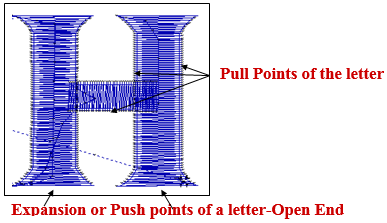 opposite side of the penetration points. You must bring those areas in, cutting them shorter. This is called Push Compensation. It does not matter if you are working with a letter or a shape. It also holds true with the angles of your shape. The amount of stitch length or pull comp that you add depends on how stretchy the fabric is, what type of underlay or how much underlay you are using or how wide the column of your segment is.
opposite side of the penetration points. You must bring those areas in, cutting them shorter. This is called Push Compensation. It does not matter if you are working with a letter or a shape. It also holds true with the angles of your shape. The amount of stitch length or pull comp that you add depends on how stretchy the fabric is, what type of underlay or how much underlay you are using or how wide the column of your segment is.
If you find that you have a design that you are currently using that does not stay in registration, you might want to try adding to the stitch length on the pull in areas. The push or expansion portion of the area or segment would need to be brought in using approximately the same measurement as you have added for the Pull compensation.
Always save your outlined designs in your native software file, to ensure that you can adjust the push and pull for various fabrics. You want the finished embroidery to look the same on a denim shirt, as it does on a polo. They will not unless you have added the right amount of pull comp and underlay to accomplish this job.
Embroidery Push and Pull with Terry Cloth
Terry cloth is basically an animal all its own. Terry can be a knit or a woven fabric and comes in varying weights, from light to heavyweight. Because of these varying factors, the underlay and pull comp that you add depends on both the weight of the fabric and the size of the embroidery design or monogram. You will have to experiment on a sample before you can come up with your final settings. Once you have that you will want to save these settings and use them all of the time for your terry fabrics. Keep in mind that all software packages are different and all embroidery machines are different so there will always be adjustments. Sometimes this means that you have to digitize the actual 0000000pull comp into your design if you are not getting the results that you need or that will work with your machine. If you are creating your own underlay, you must know how much pull comp you are applying before you even create your underlay.
I hope that I have helped you to understand pull comps a little bit better. I know that this subject is huge and tough to grasp but if you do a lot of experimenting and keep track of your settings, you will soon gain a whole lot more knowledge of this huge subject and will be able to create better-looking embroidery designs.0000000000000000000000000000000000000

 Create several Design Layouts Options for your customer to choose from. By giving your customer choices of different layouts for him to look at before he places his order, you prevent him from asking you to create his logo with several different options for his approval.
Create several Design Layouts Options for your customer to choose from. By giving your customer choices of different layouts for him to look at before he places his order, you prevent him from asking you to create his logo with several different options for his approval. tempting to want to show our customers all of the lettering styles that we have available.
tempting to want to show our customers all of the lettering styles that we have available. Your showroom should be complete with high-quality embroidery samples that are tagged with all of the order information that is applicable to that product sample.
Your showroom should be complete with high-quality embroidery samples that are tagged with all of the order information that is applicable to that product sample. chart from the company where you purchase your thread.
chart from the company where you purchase your thread. An organized ordering system is simple to put into place. This is true when you have all of your information computerized and even if you are using paper forms to be filled out while you are waiting on the customer. You can create Sales Order Packets with all of your forms included so that you do not have to look for your information forms while you are working with your customer. Inside of this Sales Order Packet, you should have:
An organized ordering system is simple to put into place. This is true when you have all of your information computerized and even if you are using paper forms to be filled out while you are waiting on the customer. You can create Sales Order Packets with all of your forms included so that you do not have to look for your information forms while you are working with your customer. Inside of this Sales Order Packet, you should have:






 opposite side of the penetration points. You must bring those areas in, cutting them shorter. This is called Push Compensation. It does not matter if you are working with a letter or a shape. It also holds true with the angles of your shape. The amount of stitch length or pull comp that you add depends on how stretchy the fabric is, what type of underlay or how much underlay you are using or how wide the column of your segment is.
opposite side of the penetration points. You must bring those areas in, cutting them shorter. This is called Push Compensation. It does not matter if you are working with a letter or a shape. It also holds true with the angles of your shape. The amount of stitch length or pull comp that you add depends on how stretchy the fabric is, what type of underlay or how much underlay you are using or how wide the column of your segment is.